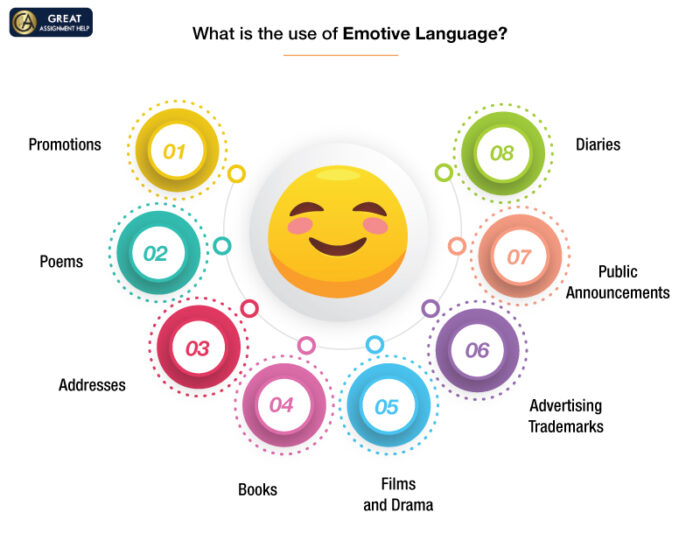Generally, in written communication, it is tough to transfer emotions to the readers in the form of words. But with the support of emotive language, this issue can be addressed easily. In a nutshell, it is a language type that uses emotive words to deliver opinions, ideas, and thoughts persuasively to the target audience and evoke their feelings. To know more about what is emotive language and its usage, keep on reading this blog post. Here, we have presented the definition of emotive language along with its importance, benefits, use, and examples in literature and real life. In addition to that, we have also recommended some best ways to use emotive language in a piece of writing.
Explore this blog post and get a complete understanding of emotive language with examples.
Definition of Emotive Language
Emotive language is one of the powerful language techniques that bring out emotions using emotions. In simple terms, it is defined as words that are used to evoke the emotions of the readers or listeners. But to effectively transfer your feelings and emotions to others, you should use the best emotive words.
The ultimate aim of emotive language is to develop an effect on people. Be it writing an essay or narrating a story, you can use emotive language in the best possible way. This language acts as a bridge between speakers and listeners.

In general, the information with emotional value will quickly reach the subconscious mind of the listeners or readers. Also, it would become easy for the target audience to memorize the content if it has some emotion quotient. Therefore, in specific, according to your content, you should carefully pick the appropriate words that have the power to pass on the emotions to others.
List of Emotive Words
Emotive language is the greatest language type or literary device that connects the readers with the writers. In particular, it is characterized by the numerous words or phrases that are used to communicate an emotion. The words can be emotive verbs, adverbs, adjectives, and abstract nouns. Also, it can be negative or positive.
- Verbs – destroyed, betrayed, and adored.
- Adverbs – angrily, proudly, and beautifully.
- Adjectives – wonderful, magical, and tragic.
- Abstract Nouns – pride, freedom, justice, and terror.

The following are a few more powerful emotive words that you can use to improve your writing.
Positive Emotive Words
Words that express a positive feeling of thankfulness or happiness are referred to as positive emotive words. Positive emotive words usually spread pleasant emotions or responses in the environment. Listed below are a few positive emotive words.
- Amusement
- Hope
- Serenity
- Gratitude
- Joy
- Interest
- Pride
Negative Emotive Words
The negative emotive words are the words that express the feeling of sadness, or misery. This type of word typically generates unhappiness, negative effects, or unpleasant emotions. Here are a few negative emotive words.
- Annoyance
- Anger
- Sadness
- Disgust
- Loneliness
- Fear
- Rage
Value-Laden Emotive Words
Value-laden emotive words or loaded words are words that express positive or negative opinions or biases toward the subject. Mostly, value-laden emotive words reflect the bias of the author. Find here, some common value-laden emotive words.
- Guilt
- Innocent
- Vital
- Valuable
Uses of Emotive Language
Till now we saw, what emotive language means. Next, let us see where to use emotive language and how writers use it.
Most of the time, during storytelling, several authors use emotive language for dramatic effect because it helps to create an impact on events and pulls the readers into the story. Moreover, it also helps the readers understand the emotions of the characters in the story.
Another major use of emotive language is in persuasive writing. To make the readers or listeners emotionally involved in the content and to make them care about the issue that is being discussed, this language is used in persuasive speeches, essays, dialogues, articles, opinion pieces, and blogs.
Typically, there is no restriction for using emotive language and hence it can be used in both oral and written communication such as debates, biographies, films, plays, poetries, short stories, novels, newspaper articles, diaries, advertisements, and public announcements.

Benefits of Using Emotive Language
As the emotive language technique has several advantages, you can very well utilize it in your daily life. The following are some key benefits that you can earn when you apply emotions in your speaking or writing.
- Establishes a strong connection with the readers and listeners
- Presents detailed information about the author
- Behaves like an expressive tool
- Helps to get a powerful reaction from the audience
- Inspires the emotions of readers
- Provides a cultural background
- Helps the readers to easily associate with the characters involved in stories or events.
The Effects of Emotive Language
The goal of using emotive language is to elicit a reaction from the target audience. Emotional language has the power to influence an audience’s behavior when it is employed skillfully. This kind of manipulating the audience is called rhetoric. As a result, using strong words can elicit a response or an argument from the audience.
The impact of emotive language is not always clear because people respond differently based on their experiences and viewpoints. However, in general, the intentional use of emotionally charged language and imagery may be a powerful instrument for changing ideas, inciting passions, and molding narratives. Therefore, the audience needs to remain aware of this strong linguistic tactic while critically examining the underlying meaning and potential prejudices at work.
Emotive Language Examples
Till now, we have seen the definition of emotive language and the different types of emotive words. Next, let us get a clear understanding of this technique with examples. The following are some examples that will show you how emotive sentences differ from non-emotive sentences of the same meaning.
For instance, let us take two simple sentences and see the dissimilarities between them.
Sentence 1: Throw that plastic can in the recycle bin
Sentence 2: Recycling plastic saves the Earth so always throw the plastic waste in the recycle bin.
Could you spot the difference in both sentences? The primary information in both sentences is to throw the plastic into the recycle bin. Here, the first sentence is commanding and doesn’t transfer any emotions. Hence, it can’t be treated as emotive language. But in the second sentence, an action is suggested along with emotion. When compared to the first sentence, the second sentence comes up with an emotional reaction. Therefore, it can be treated as a perfect emotive sentence.
Here are a few more simple and interesting examples of emotive language.
Example 1
Non-Emotive: The car hit the biker.
Emotive: The car viciously crushed the poor biker.
In this example, the emotive phrase ‘viciously crushed’ will evoke a sympathetic emotion in the minds of the readers about the accident.
Example 2
Non-Emotive: He was badly injured in a car accident.
Emotive: He was left with horrific injuries in a car accident.
Here, the term ‘horrific injury’ explains the seriousness of the injury to the readers and evokes emotions.
Example 3
Non-Emotive: The passenger was murdered on the bus.
Emotive: The innocent passenger was brutally murdered on the bus.
In the above example, the words, ‘innocent and brutally murdered’ clearly portray the events in a descriptive writing manner, and also trigger an emotion.
Example 4
Non-Emotive: The bride entered the marriage hall in good attire.
Emotive: The adorable bride entered the marriage hall in gorgeous attire.
Here, in this example, the words, ‘adorable and gorgeous’ emphasize the girl’s beauty and attire, and thus generate positive emotions.
Example 5
Non-Emotive: The whales were hunted.
Emotive: The whales were brutally slaughtered.
In the above example, the phrase ‘brutally slaughtered’ delivers a sensitive and intense meaning to the readers about the cruel criminal activity.
Similar to the usage of emotive words in the examples mentioned above, you can also use either positive or negative emotive words in your real-time conversation and convert a normal sentence into an emotive one. More commonly, literary writers and poets use emotive language as an effective tool to put forward their ideas and thoughts.
Examples of Emotive Language in Literature
Here, let us see how emotions are used in literature.
Example 1: Speech of Martin Luther King, Jr
“I Have a Dream”
This is a short excerpt from the Civil Rights Speech of Martin Luther King, Jr in 1963.
The name “Martin Luther King” is enough to enter into the contemporary world. The majority of us know about the world where the great Martin Luther King lived and the values he followed in life. So, while reading this sentence from his speech, you can easily associate it with his background.
Now, let us evaluate the excerpt.
The incomparable Martin Luther King, Jr. with his effective rhetoric obtains emotional responses from his audience. One strong persuasive technique used in his speech is emotive language.
Here, we will explain to you how with a simple excerpt from his speech.
“One hundred years later the life of the Negro is still badly disabled by the manacles of segregation and the chains of discrimination. One hundred years later the Negro lives on a lonely island of poverty amid a vast ocean of material prosperity.”
In the above-mentioned excerpt, King Jr. used emotive language to stir the emotions of the listeners. He expected to make the audience realize the need for action. Mainly, to influence the listeners to participate in the Civil Rights Movement, he effectively used emotive language in his speech.
The following is another popular example of emotive language in literature.
Example 2: Shakespeare’s Sonnet 18
Poetry is one of the best modes to express feelings or emotions through descriptive words. When speaking about poetry, we can’t ignore the literary works of William Shakespeare.
In particular, Shakespeare in his Sonnet 18 used emotive language effectively. Here is an analysis of an excerpt from Shakespeare’s Sonnet 18.
Shall I compare thee to a summer’s day?
Thou art more lovely and more temperate:
…
And every fair from fair sometimes declines,
By chance or nature’s changing course untrimmed;
But thy eternal summer shall not fade,
Nor lose possession of that fair thou ow’st;
Here, to compare his love interest to a summer day that will never fade, Shakespeare uses emotive language. Specifically, in the second line of the sonnet, he uses emotive words like ‘lovely and temperate’ to describe a person and raises an argument that the person is far better than the summer’s best day you could experience.
How to Build Emotive Language Writing Skills
Are you confused about how to develop your writing skills to effectively communicate emotions? Cool! Usually, when it comes to using emotive language, many writers find it difficult to identify a perfect emotive word. So, firstly, you should build your emotional jargon.
Next, for tuning your emotive language writing skills, you can very well read books or articles that have used emotive language techniques to present thoughts or ideas. Reading the content published in various other sources will help you to widen your knowledge of emotive words. If you have good knowledge of emotive words then try to use them in your writing. Regular practice will improve your skills.
Wrapping Up
So far, in this blog, we have seen the definition, features, and benefits of emotive language with examples. To create a strong impact in the minds of the target audience, you may very well use emotive language in your work as per the strategies suggested above. In case, you have any doubts about using emotive language, get in touch with us. We have language experts as assignment helpers in our team to guide you with implementing emotive language techniques in your writing.


